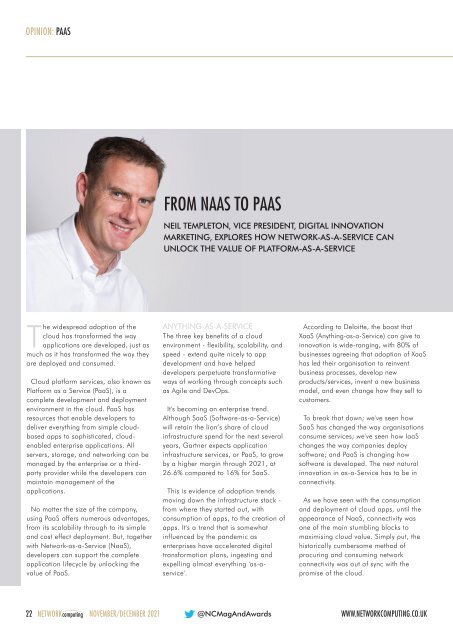NC Nov-Dec 2021
You also want an ePaper? Increase the reach of your titles
YUMPU automatically turns print PDFs into web optimized ePapers that Google loves.
OPINION: PAAS<br />
FROM NAAS TO PAAS<br />
NEIL TEMPLETON, VICE PRESIDENT, DIGITAL INNOVATION<br />
MARKETING, EXPLORES HOW NETWORK-AS-A-SERVICE CAN<br />
UNLOCK THE VALUE OF PLATFORM-AS-A-SERVICE<br />
The widespread adoption of the<br />
cloud has transformed the way<br />
applications are developed, just as<br />
much as it has transformed the way they<br />
are deployed and consumed.<br />
Cloud platform services, also known as<br />
Platform as a Service (PaaS), is a<br />
complete development and deployment<br />
environment in the cloud. PaaS has<br />
resources that enable developers to<br />
deliver everything from simple cloudbased<br />
apps to sophisticated, cloudenabled<br />
enterprise applications. All<br />
servers, storage, and networking can be<br />
managed by the enterprise or a thirdparty<br />
provider while the developers can<br />
maintain management of the<br />
applications.<br />
No matter the size of the company,<br />
using PaaS offers numerous advantages,<br />
from its scalability through to its simple<br />
and cost effect deployment. But, together<br />
with Network-as-a-Service (NaaS),<br />
developers can support the complete<br />
application lifecycle by unlocking the<br />
value of PaaS.<br />
ANYTHING-AS-A-SERVICE<br />
The three key benefits of a cloud<br />
environment - flexibility, scalability, and<br />
speed - extend quite nicely to app<br />
development and have helped<br />
developers perpetuate transformative<br />
ways of working through concepts such<br />
as Agile and DevOps.<br />
It's becoming an enterprise trend.<br />
Although SaaS (Software-as-a-Service)<br />
will retain the lion’s share of cloud<br />
infrastructure spend for the next several<br />
years, Gartner expects application<br />
infrastructure services, or PaaS, to grow<br />
by a higher margin through <strong>2021</strong>, at<br />
26.6% compared to 16% for SaaS.<br />
This is evidence of adoption trends<br />
moving down the infrastructure stack -<br />
from where they started out, with<br />
consumption of apps, to the creation of<br />
apps. It's a trend that is somewhat<br />
influenced by the pandemic as<br />
enterprises have accelerated digital<br />
transformation plans, ingesting and<br />
expelling almost everything 'as-aservice'.<br />
According to Deloitte, the boost that<br />
XaaS (Anything-as-a-Service) can give to<br />
innovation is wide-ranging, with 80% of<br />
businesses agreeing that adoption of XaaS<br />
has led their organisation to reinvent<br />
business processes, develop new<br />
products/services, invent a new business<br />
model, and even change how they sell to<br />
customers.<br />
To break that down; we've seen how<br />
SaaS has changed the way organisations<br />
consume services; we've seen how IaaS<br />
changes the way companies deploy<br />
software; and PaaS is changing how<br />
software is developed. The next natural<br />
innovation in as-a-Service has to be in<br />
connectivity.<br />
As we have seen with the consumption<br />
and deployment of cloud apps, until the<br />
appearance of NaaS, connectivity was<br />
one of the main stumbling blocks to<br />
maximising cloud value. Simply put, the<br />
historically cumbersome method of<br />
procuring and consuming network<br />
connectivity was out of sync with the<br />
promise of the cloud.<br />
22 NETWORKcomputing NOVEMBER/DECEMBER <strong>2021</strong> @<strong>NC</strong>MagAndAwards<br />
WWW.NETWORKCOMPUTING.CO.UK

















